
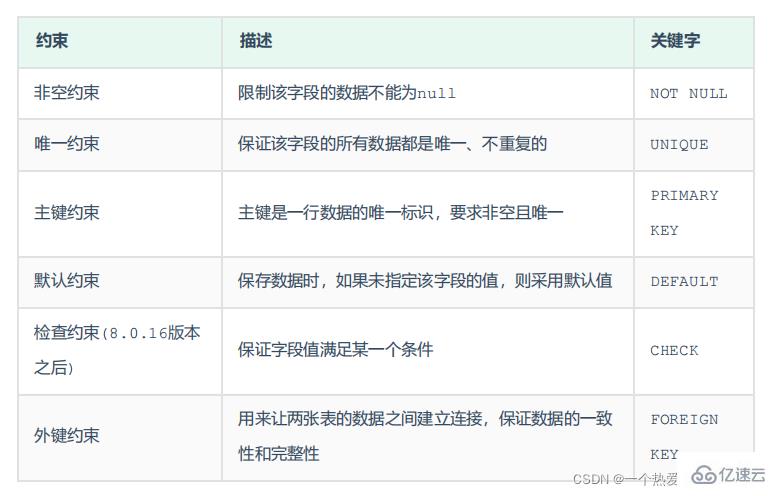
#概念:約束是作用於表格中欄位上的規則,用來限制儲存在表格中的資料。
目的:保證資料庫中資料的正確、有效性和完整性。
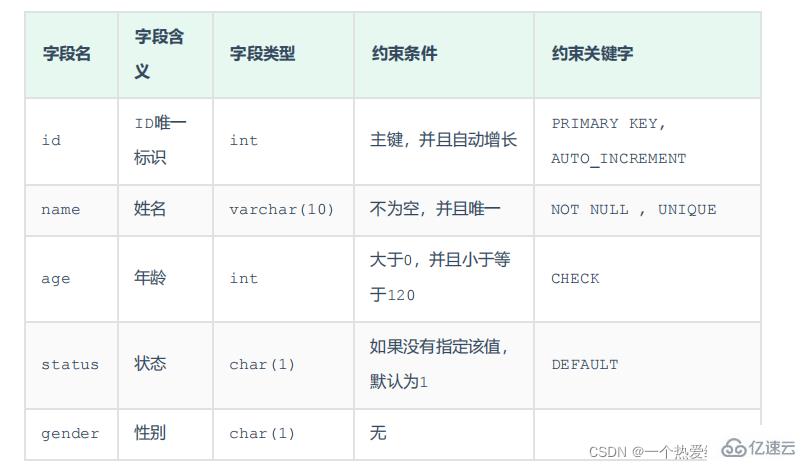
上面我們介紹了資料庫中常見的約束,以及約束涉及到的關鍵字,那麼這些約束我們到底如何在建立表、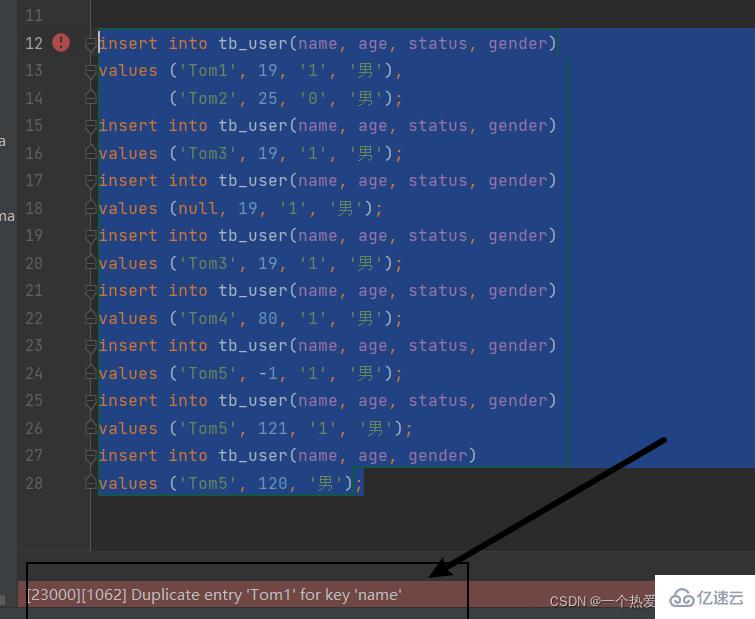
 案例需求: 根據需求,完成表格結構的建立。需求如下:
案例需求: 根據需求,完成表格結構的建立。需求如下:
CREATE TABLE tb_user
(
id int AUTO_INCREMENT PRIMARY KEY COMMENT 'ID唯一标识',
name varchar(10) NOT NULL UNIQUE COMMENT '姓名',
age tinyint unsigned COMMENT '年龄',
status char(1) default '1' COMMENT '状态',
gender char(1) COMMENT '性别'
); 如果你的Mysql是8版本之後 age可以這樣建立
如果你的Mysql是8版本之後 age可以這樣建立age int check (age > 0 && age <= 120) COMMENT '年龄' ,
insert into tb_user(name, age, status, gender)
values ('Tom1', 19, '1', '男'),
('Tom2', 25, '0', '男');
insert into tb_user(name, age, status, gender)
values ('Tom3', 19, '1', '男');
insert into tb_user(name, age, status, gender)
values (null, 19, '1', '男');
insert into tb_user(name, age, status, gender)
values ('Tom3', 19, '1', '男');
insert into tb_user(name, age, status, gender)
values ('Tom4', 80, '1', '男');
insert into tb_user(name, age, status, gender)
values ('Tom5', -1, '1', '男');
insert into tb_user(name, age, status, gender)
values ('Tom5', 121, '1', '男');
insert into tb_user(name, age, gender)
values ('Tom5', 120, '男');可見 對於我們設定name的限制: 非空 且唯一 生效。
上面,我們是透過寫SQL語句的形式來完成約束的指定,那麼加入我們是透過圖形化介面來建立表格結構時,又該如何來指定約束呢?只需要在建立表格的時候,根據我們的需要選擇對應的限制即可。

#介紹
外鍵:用來讓兩張表的資料之間建立連接,從而確保資料的一致性和完整性。
我們來看一個例子: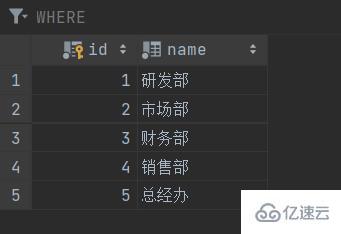

注意:目前上述兩張表,只是在邏輯上存在這樣一層關係;在資料庫層面,並未建立外鍵關聯,所以是無法保證資料的一致性和完整性的。 
沒有資料庫外鍵關聯的情況下,能夠保證一致性和完整性呢,我們來測試一下。
create table dept
(
id int auto_increment comment 'ID' primary key,
name varchar(50) not null comment '部门名称'
) comment '部门表';
INSERT INTO dept (id, name)
VALUES (1, '研发部'),
(2, '市场部'),
(3, '财务部'),
(4, '销售部'),
(5, '总经办');
create table emp
(
id int auto_increment comment 'ID' primary key,
name varchar(50) not null comment '姓名',
age int comment '年龄',
job varchar(20) comment '职位',
salary int comment '薪资',
entrydate date comment '入职时间',
managerid int comment '直属领导ID',
dept_id int comment '部门ID'
) comment '员工表';
INSERT INTO emp (id, name, age, job, salary, entrydate, managerid, dept_id)
VALUES (1, '金庸', 66, '总裁', 20000, '2000-01-01', null, 5),
(2, '张无忌', 20, '项目经理', 12500, '2005-12-05', 1, 1),
(3, '杨逍', 33, '开发', 8400, '2000-11-03', 2, 1),
(4, '韦一笑', 48, '开 发', 11000, '2002-02-05', 2, 1),
(5, '常遇春', 43, '开发', 10500, '2004-09-07', 3, 1),
(6, '小昭', 19, '程 序员鼓励师', 6600, '2004-10-12', 2, 1);#接下來,我們可以做一個測試,刪除id為1的部門資訊。
 結果,我們看到刪除成功,而刪除成功之後,部門表不存在id為1的部門,而在emp表中還有很多的員工,關聯的為id為1的部門,此時就出現了資料的不完整性。而要解決這個問題就得通過資料庫的外鍵約束。
結果,我們看到刪除成功,而刪除成功之後,部門表不存在id為1的部門,而在emp表中還有很多的員工,關聯的為id為1的部門,此時就出現了資料的不完整性。而要解決這個問題就得通過資料庫的外鍵約束。
 1). 新增外鍵
1). 新增外鍵
CREATE TABLE 表名
(
字段名 数据类型, ... [
CONSTRAINT] [
外键名称]
FOREIGN
KEY
(
外键字段名
) REFERENCES 主表
(
主表列名
) );ALTER TABLE 表名
ADD CONSTRAINT 外键名称 FOREIGN KEY (外键字段名) REFERENCES 主表 (主表列名);alter table emp
add constraint fk_emp_dept_id foreign key (dept_id) references dept (id);ALTER TABLE 表名 DROP FOREIGN KEY 外键名称;
alter table emp drop foreign key fk_emp_dept_id; 1
当添加了外键之后,在删除父表数据时引发的约束操作,我们称之为删除或更新操作。具体的删除/更新行为有以下几种:
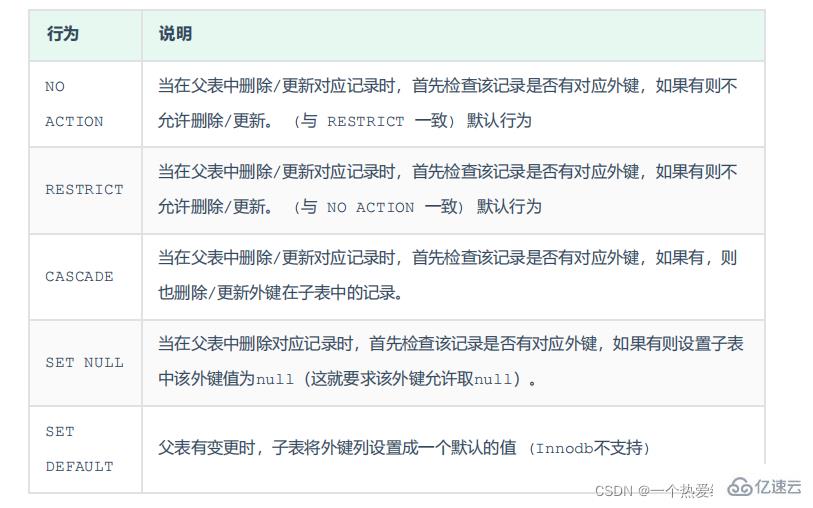
具体语法为:
ALTER TABLE 表名
ADD CONSTRAINT 外键名称 FOREIGN KEY (外键字段) REFERENCES 主表名 (主表字段名) ON UPDATE CASCADE ON DELETE CASCADE;演示如下:
由于NO ACTION 是默认行为,我们前面语法演示的时候,已经测试过了,就不再演示了,这里我们再
演示其他的两种行为:CASCADE、SET NULL。
1). CASCADE
alter table emp
add constraint fk_emp_dept_id foreign key (dept_id) references dept (id) on update cascade on delete cascade;A. 修改父表id为1的记录,将id修改为6

我们发现,原来在子表中dept_id值为1的记录,现在也变为6了,这就是cascade级联的效果
在一般的业务系统中,不会修改一张表的主键值。
B. 删除父表id为6的记录

我们发现,父表的数据删除成功了,但是子表中关联的记录也被级联删除了。
2). SET NULL
在进行测试之前,我们先需要删除上面建立的外键 fk_emp_dept_id。然后再通过数据脚本,将 emp、dept表的数据恢复了。
alter table emp
add constraint fk_emp_dept_id
foreign key (dept_id) references dept (id) on update set null on delete set null;接下来,我们删除id为1的数据,看看会发生什么样的现象。

我们发现父表的记录是可以正常的删除的,父表的数据删除之后,再打开子表 emp,我们发现子表emp 的dept_id字段,原来dept_id为1的数据,现在都被置为NULL了

这就是SET NULL这种删除/更新行为的效果。
我们之前在讲解SQL语句的时候,讲解了DQL语句,也就是数据查询语句,但是之前讲解的查询都是单表查询,而本章节我们要学习的则是多表查询操作,主要从以下几个方面进行讲解。
项目开发中,在进行数据库表结构设计时,会根据业务需求及业务模块之间的关系,分析并设计表结 构,由于业务之间相互关联,所以各个表结构之间也存在着各种联系,基本上分为三种:
一对多(多对一) 多对多 一对一
案例: 部门 与 员工的关系
关系: 一个部门对应多个员工,一个员工对应一个部门
实现: 在多的一方建立外键,指向一的一方的主键

案例: 学生 与 课程的关系
关系: 一个学生可以选修多门课程,一门课程也可以供多个学生选择
实现: 建立第三张中间表,中间表至少包含两个外键,分别关联两方主键

对应的SQL脚本:
create table student
(
id int auto_increment primary key comment '主键ID',
name varchar(10) comment '姓名',
no varchar(10) comment '学号'
) comment '学生表';
insert into student
values (null, '黛绮丝', '2000100101'),
(null, '谢逊', '2000100102'),
(null, '殷天正', '2000100103'),
(null, '韦一笑', '2000100104');
create table course
(
id int auto_increment primary key comment '主键ID',
name varchar(10) comment '课程名称'
) comment '课程表';
insert into course
values (null, 'Java'),
(null, 'PHP'),
(null, 'MySQL'),
(null, 'Hadoop');
create table student_course
(
id int auto_increment comment '主键' primary key,
studentid int not null comment '学生ID',
courseid int not null comment '课程ID',
constraint fk_courseid foreign key (courseid) references course (id),
constraint fk_studentid foreign key (studentid) references student (id)
) comment '学生课程中间表';
insert into student_course
values (null, 1, 1),
(null, 1, 2),
(null, 1, 3),
(null, 2, 2),
(null, 2, 3),
(null, 3, 4);案例: 用户与 用户详情的关系
关系: 一对一关系,多用于单表拆分,将一张表的基础字段放在一张表中,其他详情字段放在另一张表中,以提升操作效率
实现: 在任意一方加入外键,关联另外一方的主键,并且设置外键为唯一的(UNIQUE)

对应的SQL脚本:
create table tb_user
(
id int auto_increment primary key comment '主键ID',
name varchar(10) comment '姓名',
age int comment '年龄',
gender char(1) comment '1: 男 , 2: 女',
phone char(11) comment '手机号'
) comment '用户基本信息表';
create table tb_user_edu
(
id int auto_increment primary key comment '主键ID',
degree varchar(20) comment '学历',
major varchar(50) comment '专业',
primaryschool varchar(50) comment '小学',
middleschool varchar(50) comment '中学',
university varchar(50) comment '大学',
userid int unique comment '用户ID',
constraint fk_userid foreign key (userid) references tb_user (id)
) comment '用户教育信息表';
insert into tb_user(id, name, age, gender, phone)
values (null, '黄渤', 45, '1', '18800001111'),
(null, '冰冰', 35, '2', '18800002222'),
(null, '码云', 55, '1', '18800008888'),
(null, '李彦宏', 50, '1', '18800009999');
insert into tb_user_edu(id, degree, major, primaryschool, middleschool, university, userid)
values (null, '本科', '舞蹈', '静安区第一小学', '静安区第一中学', '北京舞蹈学院', 1),
(null, '硕士', '表演', '朝阳区第一小学', '朝阳区第一中学', '北京电影学院', 2),
(null, '本科', '英语', '杭州市第一小学', '杭州市第一中学', '杭州师范大学', 3),
(null, '本科', '应用数学', '阳泉第一小学', '阳泉区第一中学', '清华大学', 4);1). 删除之前 emp, dept表的测试数据
2). 执行如下脚本,创建emp表与dept表并插入测试数据
-- 创建dept表,并插入数据
create table dept
(
id int auto_increment comment 'ID' primary key,
name varchar(50) not null comment '部门名称'
) comment '部门表';
INSERT INTO dept (id, name)
VALUES (1, '研发部'),
(2, '市场部'),
(3, '财务部'),
(4, '销售部'),
(5, '总经办'),
(6, '人事部');
-- 创建emp表,并插入数据
create table emp
(
id int auto_increment comment 'ID' primary key,
name varchar(50) not null comment '姓名',
age int comment '年龄',
job varchar(20) comment '职位',
salary int comment '薪资',
entrydate date comment '入职时间',
managerid int comment '直属领导ID',
dept_id int comment '部门ID'
) comment '员工表';
-- 添加外键
alter table emp
add constraint fk_emp_dept_id foreign key (dept_id) references dept (id);
INSERT INTO emp (id, name, age, job, salary, entrydate, managerid, dept_id)
VALUES (1, '金庸', 66, '总裁', 20000, '2000-01-01', null, 5),
(2, '张无忌', 20, '项目经理', 12500, '2005-12-05', 1, 1),
(3, '杨逍', 33, '开发', 8400, '2000-11-03', 2, 1),
(4, '韦一笑', 48, '开发', 11000, '2002-02-05', 2, 1),
(5, '常遇春', 43, '开发', 10500, '2004-09-07', 3, 1),
(6, '小昭', 19, '程序员鼓励师', 6600, '2004-10-12', 2, 1),
(7, '灭绝', 60, '财务总监', 8500, '2002-09-12', 1, 3),
(8, '周芷若', 19, '会计', 48000, '2006-06-02', 7, 3),
(9, '丁敏君', 23, '出纳', 5250, '2009-05-13', 7, 3),
(10, '赵敏', 20, '市场部总监', 12500, '2004-10-12', 1, 2),
(11, '鹿杖客', 56, '职员', 3750, '2006-10-03', 10, 2),
(12, '鹤笔翁', 19, '职员', 3750, '2007-05-09', 10, 2),
(13, '方东白', 19, '职员', 5500, '2009-02-12', 10, 2),
(14, '张三丰', 88, '销售总监', 14000, '2004-10-12', 1, 4),
(15, '俞莲舟', 38, '销售', 4600, '2004-10-12', 14, 4),
(16, '宋远桥', 40, '销售', 4600, '2004-10-12', 14, 4),
(17, '陈友谅', 42, null, 2000, '2011-10-12', 1, null)dept表共6条记录,emp表共17条记录。
多表查询就是指从多张表中查询数据。
原来查询单表数据,执行的SQL形式为:select * from emp;
那么我们要执行多表查询,就只需要使用逗号分隔多张表即可,如: select * from emp , dept ; 具体的执行结果如下:
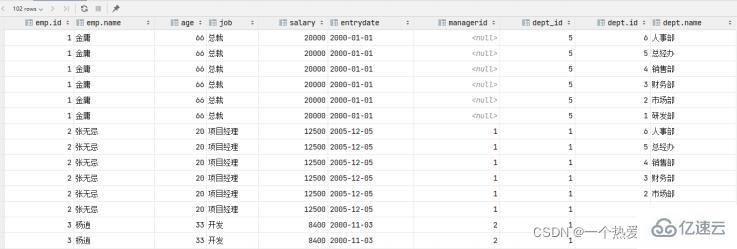
此时,我们看到查询结果中包含了大量的结果集,总共102条记录,而这其实就是员工表emp所有的记录 (17) 与 部门表dept所有记录(6) 的所有组合情况,这种现象称之为笛卡尔积。接下来,就来简单 介绍下笛卡尔积。
笛卡尔积: 笛卡尔乘积是指在数学中,两个集合A集合 和 B集合的所有组合情况。

而在多表查询中,我们是需要消除无效的笛卡尔积的,只保留两张表关联部分的数据。

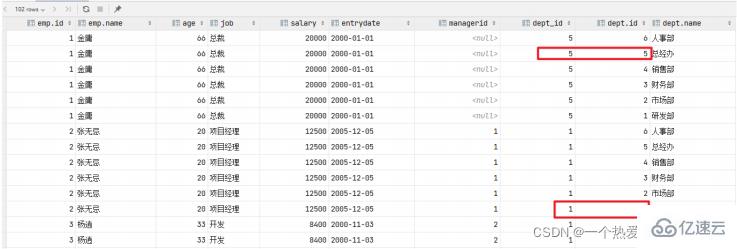
在SQL语句中,如何来去除无效的笛卡尔积呢? 我们可以给多表查询加上连接查询的条件即可。
select * from emp , dept where emp.dept_id = dept.id;
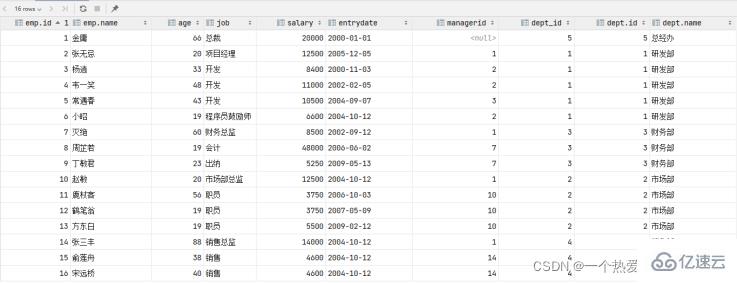
在多表查询中,由于id为17的员工没有dept_id字段的值,因此根据连接查询条件无法找到。
连接查询
内连接:相当于查询A、B交集部分数据
外连接:
左外连接:查询左表所有数据,以及两张表交集部分数据
右外连接:查询右表所有数据,以及两张表交集部分数据
自连接:当前表与自身的连接查询,自连接必须使用表别名
子查询
内连接查询的是两张表交集部分的数据。(也就是绿色部分的数据)
内连接的语法分为两种: 隐式内连接、显式内连接。先来学习一下具体的语法结构。
1). 隐式内连接
SELECT 字段列表 FROM 表1 , 表2 WHERE 条件 ... ;
2). 显式内连接
SELECT 字段列表 FROM 表1 [ INNER ] JOIN 表2 ON 连接条件 ... ;
案例:
A. 查询每一个员工的姓名 , 及关联的部门的名称 (隐式内连接实现)
表结构: emp , dept
连接条件: emp.dept_id = dept.id
select emp.name, dept.name
from emp,
dept
where emp.dept_id = dept.id;
-- 为每一张表起别名,简化SQL编写
select e.name,d.name from emp e , dept d where e.dept_id = d.id;B. 查询每一个员工的姓名 , 及关联的部门的名称 (显式内连接实现) --- INNER JOIN ...
ON ...
表结构: emp , dept
连接条件: emp.dept_id = dept.id
select e.name, d.name
from emp e
inner join dept d on e.dept_id = d.id;
-- 为每一张表起别名,简化SQL编写
select e.name, d.name from emp e join dept d on e.dept_id = d.id;表的别名:
①. tablea as 别名1 , tableb as 别名2 ;
②. tablea 别名1 , tableb 别名2 ;
注意事项:一旦为表起了别名,就不能再使用表名来指定对应的字段了,此时只能够使用别名来指定字段。
外连接分为两种,分别是:左外连接 和 右外连接。具体的语法结构为:
1). 左外连接
SELECT 字段列表 FROM 表1 LEFT [ OUTER ] JOIN 表2 ON 条件 ... ;
左外连接相当于查询表1(左表)的所有数据,当然也包含表1和表2交集部分的数据。
2). 右外连接
SELECT 字段列表 FROM 表1 RIGHT [ OUTER ] JOIN 表2 ON 条件 ... ;
右外连接相当于查询表2(右表)的所有数据,当然也包含表1和表2交集部分的数据。
案例:
A. 查询emp表的所有数据, 和对应的部门信息
由于需求中提到,要查询emp的所有数据,所以是不能内连接查询的,需要考虑使用外连接查询。
表结构: emp, dept
连接条件: emp.dept_id = dept.id
select e.*, d.name
from emp e
left outer join dept d on e.dept_id = d.id;
select e.*, d.name
from emp e
left join dept d on e.dept_id = d.id;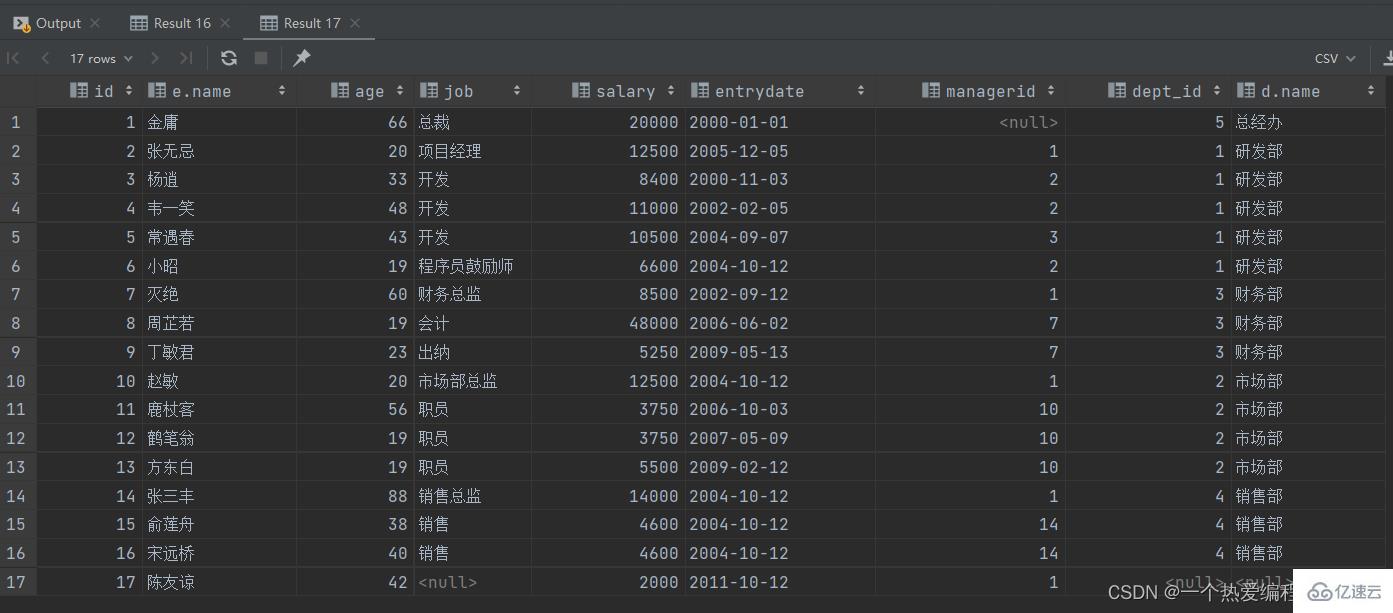
B. 查询dept表的所有数据, 和对应的员工信息(右外连接)
由于需求中提到,要查询dept表的所有数据,所以是不能内连接查询的,需要考虑使用外连接查询。
表结构: emp, dept
连接条件: emp.dept_id = dept.id
select d.*, e.*
from emp e
right outer join dept d on e.dept_id = d.id;
select d.*, e.*
from dept d
left outer join emp e on e.dept_id = d.id;
注意事项:
左外连接和右外连接是可以相互替换的,只需要调整在连接查询时SQL中,表结构的先后顺
序就可以了。而我们在日常开发使用时,更偏向于左外连接。
自我关联查询是指在查询中将一个表自己连接,即多次连接同一张表。我们先来学习一下自连接的查询语法:
SELECT 字段列表 FROM 表A 别名A JOIN 表A 别名B ON 条件 ... ;登入後複製而对于自连接查询,可以是内连接查询,也可以是外连接查询
案例:
A. 查询员工 及其 所属领导的名字
表结构: emp
select a.name , b.name from emp a , emp b where a.managerid = b.id;
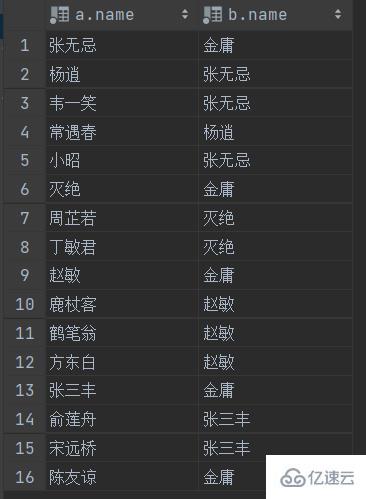
B. 查询所有员工 emp 及其领导的名字 emp , 如果员工没有领导, 也需要查询出来
表结构: emp a , emp b
select a.name '员工', b.name '领导'
from emp a
left join emp b on a.managerid = b.id;注意事项:
在自连接查询中,必须要为表起别名,要不然我们不清楚所指定的条件、返回的字段,到底
是哪一张表的字段。
对于union查询,就是把多次查询的结果合并起来,形成一个新的查询结果集。
SELECT 字段列表 FROM 表A... UNION [ ALL ] SELECT 字段列表 FROM 表B....;
对于联合查询的多张表的列数必须保持一致,字段类型也需要保持一致。
union all 会将全部的数据直接合并在一起,union 会对合并之后的数据去重。
案例:
A. 将薪资低于 5000 的员工 , 和 年龄大于 50 岁的员工全部查询出来.
当前对于这个需求,我们可以直接使用多条件查询,使用逻辑运算符 or 连接即可。在这里,我们也可以使用 UNION/UNION ALL 进行联合查询
select * from emp where salary < 5000 union all select * from emp where age > 50;
union all查询出来的结果,仅仅进行简单的合并,并未去重。

select * from emp where salary < 5000 union select * from emp where age > 50;

union 联合查询,会对查询出来的结果进行去重处理。
注意:
如果多条查询语句查询出来的结果,字段数量不一致,在进行union/union all联合查询时,将会报
错。如:

1). 概念
SQL语句中嵌套SELECT语句,称为嵌套查询,又称子查询。
SELECT * FROM t1 WHERE column1 = ( SELECT column1 FROM t2 );
子查询外部的语句可以是INSERT / UPDATE / DELETE / SELECT 的任何一个。
2). 分类
根据子查询结果不同,分为:
A. 标量子查询(子查询结果为单个值)
B. 列子查询(子查询结果为一列)
C. 行子查询(子查询结果为一行)
D. 表子查询(子查询结果为多行多列)
根据子查询位置,分为:
A. WHERE之后
B. FROM之后
C. SELECT之后
子查询返回的结果是单个值(数字、字符串、日期等),最简单的形式,这种子查询称为标量子查询。
常用的操作符:= <> > >= < <=
案例:
A. 查询 "销售部" 的所有员工信息
完成这个需求时,我们可以将需求分解为两步:
查询 "销售部" 部门ID
select id from dept where name = '销售部';
根据 "销售部" 部门ID, 查询员工信息
select * from emp where dept_id = (select id from dept where name = '销售部');

B. 查询在 "方东白" 入职之后的员工信息
完成这个需求时,我们可以将需求分解为两步:
查询 方东白 的入职日期
select entrydate from emp where name = '方东白';
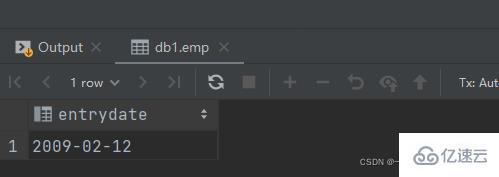
查询指定入职日期之后入职的员工信息
select * from emp where entrydate > (select entrydate from emp where name = '方东白');

子查询返回的结果是一列(可以是多行),这种子查询称为列子查询。
常用的操作符:IN 、NOT IN 、 ANY 、SOME 、 ALL
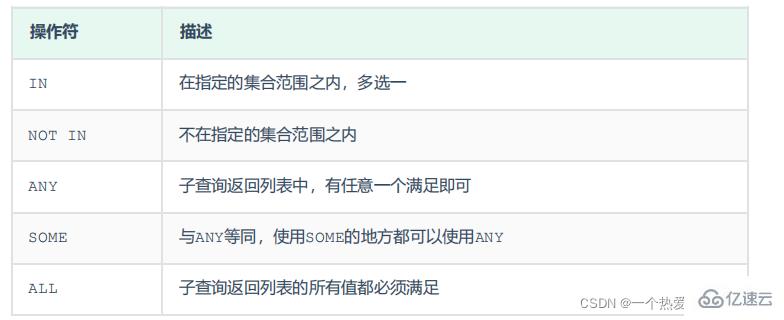
案例:
A. 查询 "销售部" 和 "市场部" 的所有员工信息
分解为以下两步:
查询 "销售部" 和 "市场部" 的部门ID
select id from dept where name = '销售部' or name = '市场部';

根据部门ID, 查询员工信息
select * from emp where dept_id in (select id from dept where name = '销售部' or name = '市场部');

B. 查询比 财务部 所有人工资都高的员工信息
分解为以下两步:
查询所有 财务部 人员工资
select salary from emp where dept_id = (select id from dept where name = '财务部');
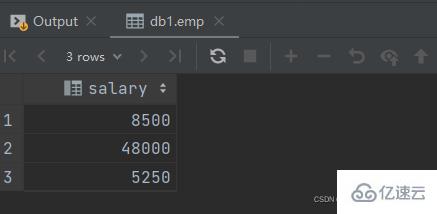
比 财务部 所有人工资都高的员工信息
select * from emp where salary > all (select salary from emp where dept_id = (select id from dept where name = '财务部'));
C. 查询比研发部其中任意一人工资高的员工信息
分解为以下两步:
查询研发部所有人工资
select salary from emp where dept_id = (select id from dept where name = '研发部');
比研部其中任意一人工资高的员工信息
select * from emp where salary > any (select salary from emp where dept_id = (select id from dept where name = '研发部'));
子查询返回的结果是一行(可以是多列),这种子查询称为行子查询。
常用的操作符:= 、<> 、IN 、NOT IN
案例:
A. 查询与 "张无忌" 的薪资及直属领导相同的员工信息 ;
这个需求同样可以拆解为两步进行:
查询 "张无忌" 的薪资及直属领导
select salary, managerid from emp where name = '张无忌';
查询与 "张无忌" 的薪资及直属领导相同的员工信息 ;
select * from emp where (salary, managerid) = (select salary, managerid from emp where name = '张无忌');

子查询返回的结果是多行多列,这种子查询称为表子查询。
常用的操作符:IN
案例:
A. 查询与 "鹿杖客" , "宋远桥" 的职位和薪资相同的员工信息
分解为两步执行:
查询 "鹿杖客" , "宋远桥" 的职位和薪资
select job, salary from emp where name = '鹿杖客' or name = '宋远桥';
查询与 "鹿杖客" , "宋远桥" 的职位和薪资相同的员工信息
select * from emp where (job, salary) in (select job, salary from emp where name = '鹿杖客' or name = '宋远桥');
重新表述为:检索入职日期晚于"2006-01-01"的员工信息和他们所在的部门信息
分解为两步执行:
入职日期是 "2006-01-01" 之后的员工信息
select * from emp where entrydate > '2006-01-01';
.查询这部分员工, 对应的部门信息;
select e.*, d.*
from (select * from emp where entrydate > '2006-01-01') e
left join dept d on e.dept_id = d.id;以上是MySQL約束與多表查詢實例分析的詳細內容。更多資訊請關注PHP中文網其他相關文章!




